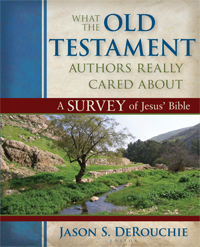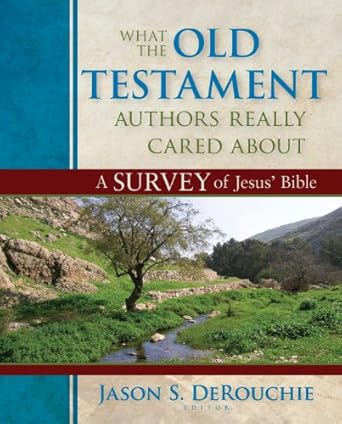Today we continue our interview with Dr. Jason DeRouchie. If you missed yesterday’s interview you can catch up here.
Books At a Glance:
Can you explain briefly your characterizations of the three divisions of the Old Testament?
DeRouchie:
The kingdom story that frames Scripture is developed through five interrelated, progressing covenants, all of which are fulfilled in Christ: the Adamic/Noahic, Abrahamic, Mosaic, Davidic, and new. Of these, the most dominant from a literary perspective are the old (Mosaic) covenant and the new covenant in Jesus (see Jer 31:31–32). Indeed, the early church named the two parts of the Bible after these covenant (Old Testament and New Testament).
The old covenant is what controls the message of the Old Testament’s three divisions. The old covenant is established in the Law, enforced in the Prophets, and enjoyed in the Writings.
- In the Law, Genesis provides a context for God’s global purposes through Israel. Exodus through Deuteronomy then sets forth the covenant that would guide and ultimately condemn God’s people, displaying Christ as the only hope of the world.
- The Prophets detail through both narrative and commentary the movement of the nation from conquest to exile as God proves his covenant faithfulness both to bless and to curse. The narrative of the Former Prophets first describes what happened in Israel’s demise and destruction, and then the prophetic commentary of the Latter Prophets clarifies why it happened––namely, covenant rebellion always results in tragedy. We read the history of the covenant in light of the covenant, and we view the prophets themselves as covenant preachers, who judge and instruct in accordance with Moses’ teaching and who proclaim future judgment and hope in light of the covenant curses and blessings.
- The Writings shift the focus from sin to kingdom hope. The commentary of the Former Writings gives voice to how the faithful remnant was to live in hope of the coming Messiah and kingdom. The laments and praises evidenced in song and story are all expressions of a covenant people before a covenant God, and they celebrate God’s reign over God’s people in God’s land on both a national and global scale. Then the narrative of the Latter Writings gives tangible evidence of kingdom hope by highlighting stories of God’s physical preservation and restoration, all in anticipation of full reconciliation with God for both Israel and the world through the Davidic royal deliverer.

Books At a Glance:
Do you argue that these characterizations of the old covenant – established, enforced, and enjoyed – should be understood only in broad terms or that they hold true in each particular book? For example, how would the books of Job, Ruth, and Lamentations reflect the “enjoyment” of the old covenant?
DeRouchie:
These categories are general representations of what the various books in each of the three canonical divisions are communicating together. To take the Former Writings as an example, I see all the books working together to identify what the life of an old covenant believer would look like if he was indeed satisfied in God, submitted to his sovereignty, and trusting him to save, ultimately through his Messiah. Here are my summaries for each of these books:
- Ruth: Prelude affirming the kingdom hope of Yahweh’s redeeming grace through the line of David.
- Psalms: Hope for those delighting in and submitting to God’s kingship through his Word and Messiah.
- Job: Hope for those fearing God for who he is, not for what he gives or takes away.
- Proverbs: Hope for those acting wisely––who fear God, turn from evil, and live in light of the future.
- Ecclesiastes: Hope for those fearing and following God in pleasure and pain despite life’s enigmas.
- Song of Songs: Hope for those celebrating sexuality in the context of marriage.
- Lamentations: Hope for those remaining confident in God’s reign and faithfulness to his own.
Can we really see books like Job, Ruth, and Lamentations as reflecting the “enjoyment” of the old covenant? Yes, when we realize that their messages are designed to incite old covenant suffering saints to persevering joy, contentment, and trust in God and to instill hope through suffering and in light of the future glory of the kingdom. Job urges those in distress to believe that, even when all one’s physical treasures and health are taken away, God is worth fearing and trusting. Similarly, Ruth calls readers to deep-seated hope in a God who used a redeemer from Bethlehem to deliver David’s ancestors from exile (in Moab) and emptiness and who would do so again through a new and greater David for those who believe. Finally, Lamentations insights readers experiencing the dark discipline of the sovereign God to trust in the possibility that fresh mercy will rise at dawn. These books are calls to joy – echoes of a faithful remnant urging their peers not to become dissatisfied with God’s ways or timing but to retain their belief in his goodness, their trust in his kingdom promises, and their hope in the coming Messiah (cf. Rom 5:3–5; Phil 4:4–7; Jam 1:2; 1 Pet 1:6–7; 4:13).
Books At a Glance:
How do these broad divisions with their respective characterizations anticipate Jesus?
DeRouchie:
The old covenant that is established in the Law bore a ministry of condemnation, as testified to explicitly by both Moses (Deut 31:29; cf. 4:25–29; 30:1) and Paul (2 Cor 3:9). Christians are no longer under the old covenant as a written legal code (Acts 15:10, 19; Gal 5:1–12; Eph 2:14–16), which brought forth an age of death to the majority of Israel who retained hard hearts and which has now been superseded through the eschatological, new covenant work of Christ (Gal 3:25; cf. 2 Cor 3:6–8, 11; Heb 7:12; 8:13; 10:9).
Deuteronomy anticipates a prophet like Moses who would know God, mediate his words, teach authoritatively, and match his message with great signs and wonders (Deut 18:15–18; 34:10–12), and the book intimates that his rising would come in the age after curse when hearts would be transformed (4:30–31; 30:1–6). Whereas the Prophets (and the conclusion of Old Testament history) end where they began – with Moses’ old covenant teaching still standing as the authority (Josh 1:7–8; Mal 4:4), the New Testament announces the end of an age (Matt 11:10–14) and the inauguration of fulfillment (5:17–20). “The kingdom of heaven is at hand” (3:2). Jesus is the prophet who supersedes Moses (Luke 7:16; Acts 3:22–23, 26), and his teaching through his apostles is what guides the church (Matt 7:24; 17:5; 28:18–20; John 16:12–14; 17:8, 18, 20; 2 Thess 2:15; Heb 1:1–2).
Christ alone provides freedom from the law’s condemning power and supplies all the righteousness that the law requires (Rom 3:21–26; Phil 3:8–9; Col 2:13–14). He is the embodiment of all wisdom (Matt 11:19; 12:42; 13:54), the one who fulfills the laws demands (Rom 5:19; 1 John 3:4–5), and the substance of all old covenant shadows (Col 2:16–17; Heb 9:12; 10:1). All the Old Testament points to Christ, and from him all fulfillment comes. Jesus’ saving work is the fulcrum upon which the entire Bible pivots. The story of God’s kingdom program progressively develops through the narrative and commentary of the old covenant Law, Prophets, and Writings only to find resolve in the person and work of Jesus. The Bible is about God’s kingdom through covenant for his glory in Christ.
Books At a Glance:
We have seen your For Our Good Always, your new Festschrift in honor of Daniel Block, and we hope to feature it soon here at Books At a Glance. Do you have any other writing projects in the works that we should watch for?
DeRouchie:
As for book projects, I am completing two commentaries (one short, one long) on the book of Zephaniah, which I believe to be a great summons to satisfaction – a call to preserving trust in God in order to see consummated one’s joy in God and God’s joy in his redeemed. I also am working on a brief Gospel-centered glance at the Old Testament for parents of young children and a textlinguistic, rhetorical, and theological commentary on Deuteronomy. The completion of the latter, however, is likely still over a decade out.

